Roslyn Cameron is public support and outreach coordinator at the Charles Darwin Research Station on the Galapagos Islands.
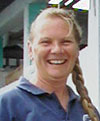
Monday, 30 Apr 2001
ISLA SANTA CRUZ, Galapagos
A five-minute ride along the mangrove-lined oceanfront road on my rusty old bike finds me at the Charles Darwin Research Station. After four years, my morning commute still never ceases to fill me with awe. Bypassing the station’s main buildings, I spend a few minutes alone with the rugged ocean seascape on the way to the dining room, an open-air area overlooking the turquoise ocean, before I drop off containers for my “take away,” which I’ll pick up at lunchtime.
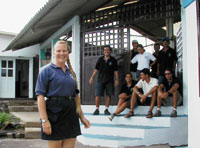
Staff in front of the marine biology building.
Photo: CDRS.
Since its humble beginnings in the 1960s, the CDRS has been the home base for many successful and innovative conservation programs. In the past decade, we’ve expanded several programs and developed new departments as the threats to the island ecology change and grow. Next to the dining room are the recently refurbished marine biology buildings, home to one of the fastest growing departments, with a staff now near 40, stationed on three islands. Industrial fishing activities increased substantially around the islands in the early 1990s. Scientists working for conservation reacted by stepping up their efforts to monitor marine life. Now, the future plans and decisions of the recently created Galapagos Marine Reserve may depend on the technical reports produced by our hardworking team, and the pressure is on to find the resources to continue this and other vital programs.
My office is in the Van Straelen interpretation center, settled amongst native vegetation on the edge of the station. The building is old and in need of a facelift, but I have an enviable ocean view. From the balcony, I check to see which boats are in the bay to get an idea of how busy we will be with video presentations and handling questions from guides and tourists alike. Through many newly initiated outreach programs, we are informing and motivating visitors, guides, tourist operators, and agencies to join us and support the work of the CDRS.
I switch on my laptop and watch the world pour into my niche, 1,000 kilometers out in the middle of the Pacific. It is a fairly recent phenomenon for us to be online and available to people around the world — only a couple of years ago we could barely make a telephone call. This morning, I sift through hundreds of emails, responding to everything from info requests from 7th-graders to press and scientific inquiries. It has been nigh impossible to create standard responses, so each requires an individual answer. The emails give me a lot of leads for fund-raising, affiliations, and help organizing the logistics for the many film groups and journalists that come to record the happenings on these magical islands.
Among the packages and letters in the regular mail are copies of videos from the BBC and Partridge films, just two of the dozens of film groups that have worked in the islands in the last year. I coordinate any involvement of the CDRS staff or facilities in films, arranging logistics, proposing themes, and quite often appearing in the films themselves. Film groups have been very receptive to our new policy encouraging a focus on the work of the station in their productions. Without the partnership of CDRS and the Galapagos National Park Service, Galapagos would not be the natural Mecca for media it is today. Our latest emphasis has been on promoting the work of the invertebrates and plant departments. Invasive plants and insects represent some of the greatest threats to the islands and some of the hardest projects to fund. Another package contains a visiting scientist’s project to retrace Darwin’s steps. There’s also an autographed copy of a new field guide I reviewed, invitations for dinner, cocktails, and even a wedding invitation from one of my staff.
I spend a couple of hours with Robert Bensted Smith, director of the CDRS. During his five years at the station, he has promoted and engineered quite impressive changes, including the formation of a public relations department. Until we find the elusive development director we have been seeking, management of the PR department rests squarely on his shoulders, which puts me in the privileged position of having ready access to this very busy man. We catch up on the news from the Charles Darwin Foundation’s assembly meetings, from which he has just returned, and discuss the upcoming Foundation Council meetings in Washington, D.C. I leave him feeling inspired that the Foundation continues to move forward, adapting to the needs, pressures, and demands of being a major force in Galapagos and world conservation.
The phone rings constantly, messages fly back and forth — a typical day at the office. I fill my day supervising our multilingual staff, which gives presentations, does translations, and creates materials for the design team. Tourists stop by to learn about the work of the station and guides drop in to catch up on the latest news and chat. A lost tourist turns out to have the surname Beagle, and he becomes a Friend of Galapagos in honor of Darwin’s ship!
In all, a busy and successful day. I silently promise myself and my son that the computer will not go home with me tonight.
Tuesday, 1 May 2001
ISLA SANTA CRUZ, Galapagos
Different day, but the scenery en route to the dining room at the edge of the ocean is always inspiring. The tide is out and I can see a small manta ray in the shallows. The station launch, the Spondylus, is not at the dock — the marine team is out in the field monitoring transects on the ocean bottom. They are busy counting and cataloguing the marine life for the upcoming Galapagos Marine Reserve zoning discussions. The data could provide the determining factors for this year’s fishing calendar. I enjoy the view and a freshly squeezed juice with the head of the vertebrates ecology restoration department, Howard Snell, and his wife, Heidi, an accomplished artist, scientist, and boat captain.
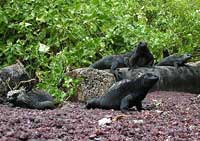
Creeping lizards! (Galapagos iguanas.)
Photo: CDRS.
The Snells have spent over 23 years involved in Galapagos research, with iguanas being their personal passion. Howard shares his time between the Charles Darwin Research Station and teaching at the University of New Mexico. After a few minutes with them, my sense of humor is sharpened for the day.
There is little respite from the heat — the temperature’s been in the 90s for weeks. Seeking refuge in my air-conditioned office, I am grateful that computers need to be kept in cool conditions. The first news I receive has been long awaited — the new website is finally online. Sara, an amiable young American woman, and our Swedish graphic designer, Mats, have put together the first stage of what will be a very comprehensive website.
Mats drops by and tells me that we have received the electronic copy of Galapagos: A Natural History by Michael H. Jackson. That’s great news. Michael has been involved with Galapagos studies for over 20 years, and his field guide is recognized as one of the most comprehensive. It is a boon for the website, as now we do not need to write
articles about what a booby or a giant tortoise eats for breakfast, or how many eggs the birds of Galapagos lay. I proudly spread the word through our new email distribution lists. Paola has worked hard for almost a year to organize email lists and define categories for all the information that we now can channel simply and effectively. I discuss the politics of information distribution with her. The Galapagos National Park, barely a hundred yards through the brush, now has a public relations department. It’s good for my work, and great to see how both the GNPS and the CDRS are able to expand while continuing to work together in a unique government/nonprofit relationship.
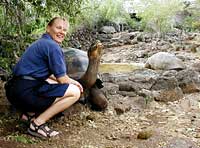
Me, with tortoises.
Photo: CDRS.
New information arrives about the Opuntia cactus restoration program on Espanola Island. A very patient Ecuadorian scientist has been growing these giants of the vegetable world from seed at the station. The “babies” have been brought back to the island to begin to reforest an area where stands of Opuntia once stood nearly 15 feet high, before being devastated by hordes of feral goats. The goats are gone now and the Opuntia and the captive-bred tortoises from the CDRS can safely return home.
The sign on our door says “Welcome, please come in,” and a couple of tourists do just that. They are interested in learning more about the work of the CDRS and the latest news on the January oil spill. They manage a large park in Europe, so we swap cards and spend some time talking shop. Many of the problems that threaten other protected places, such as deforestation, pollution, etc., are reduced in dimension and geographic extension in Galapagos. The threat of introduced species, which have entered the islands both voluntarily and involuntarily, is one that has the potential to destroy many of the unique species of this oceanic archipelago. Treating the problems caused by existent invasive species and preventing the introduction of new invasives is complex, and the answers are both long-term and costly.
Howard and his team have been instrumental in implementing the development of a GIS system for Galapagos, developing basic cartography, and expanding the inexpensive but effective use of GPS (Global Positioning System) to help record data. Part of the outreach program involves developing a monitoring program on tourist vessels. The 80 registered tourist vessels have huge potential for aiding in the field with data collection.
Cindy Manning, the expedition leader from the cruise ship Polaris calls to arrange details for the presentation I’m scheduled to give on the ship tonight. Upon the ship’s arrival in 1997, its operator, Lindblad Expeditions, approached the GNPS and CDRS about how the company could become directly involved with conservation programs on the islands. Tonight, I will be a guest presenter, part of a very successful program that was created through Lindblad Expeditions and the Galapagos Conservation Fund. Cindy gives me the list of project information they’d like onboard. My son, Mason, can come with me tonight, as there are children on this tour. It’s nice to be able to include him in my work, and we both will get a chance to have some treats that we can’t get in the stores in town.
Emma, another Polaris expedition leader, also drops in. The station has begun to actively seek qualified divers amongst the guides to help with the species monitoring program. Emma has some ideas about establishing a program to encourage guides to participate in scientific field activities. She has recently finished helping the marine biology department and wants her legacy to be an easy-to-follow system for other divers who want to lend a hand.
I leave the office early today, as I need to get myself and Mason ready to go out to the Polaris for the evening. By 5:30, we are washed, Mason is fed, and a dingy is at the public dock to transport us, along with the remaining passengers, to the ship. I spend the next three hours in front of an 80-person audience, talking about what we do at the station and encouraging their support. It’s fun, the food’s good, and Mason falls asleep during my presentation, so I stay to dance to the local folk musicians. Still, it has been a long day and I’m glad to get home and to bed by 10 p.m.
Wednesday, 2 May 2001
ISLA SANTA CRUZ, Galapagos
It’s still school holidays, so I let myself and Mason sleep in and start my day around 8 a.m. Riding to work, I remember the conversations I had onboard the Polaris last night. I spoke with a person interested in funding a scholarship for a Galapagos resident. It’s quite a large financial commitment over five years, but a great chance for someone from the island to pursue a career in science. The Charles Darwin Foundation has trained hundreds of Ecuadorian scientists by means of our volunteer, thesis supervision, and scholarship programs. Almost 20 percent of our current staff were once students in the institution.
Today’s surprise is the resignation of our Ecuadorian public relations office administrator. She has been accepted to study in the U.K. I add her job profile to my list and stop by the volunteer department to list the four new staff I will need in the next few months. We need to start looking now, as the Special Law for Galapagos that we all worked so hard to achieve to protect and preserve the archipelago means it takes quite a bit of paperwork to bring nonresidents into the islands. Because I need staff with administrative and computer skills who are at least trilingual, I contact universities on the mainland in Quito. There are also some interesting candidates already on file, so I leave with a bunch of folders under my arm to review later. There is never a shortage of people who want to work with us — resumes arrive by the dozens each week.
As an extra bonus for the morning, an ecologist/biologist from Santa Cruz, Calif.,b volunteering with the marine biology department needs accommodation. I now have a new roommate and some relief from the financial strain that comes with working more for love than for money. The costs of living in Galapagos are high, relative to our modest salaries — that’s what we pay for the privilege of living in paradise.

The tortoise and the hair.
Photo: CDRS.
The resident herpetologist overseeing our captive breeding program for the Galapagos giant tortoise mentions the possibility that Harriet, the famous Galapagos tortoise now living in Australia, could possibly be from a species believed to be extinct. He’s found references to this famous reptile in DNA studies on the giant tortoise in Galapagos and in zoos around the world. My PR and fund-raising mind runs riot with the thought of locating an “extinct” species — especially a female.
While our captive breeding program for the endangered Galapagos giant tortoise has been highly successful, we have a constant reminder and a sad symbol of the plight of these reptiles in Lonesome George, the last of the species from the island of Pinta. When he dies, his species will be added to the long list of plants and animals worldwide that have perished because of human actions. Measures taken by the CDF to avoid this have been unsuccessful thus far. Visitors from all over the world visit George in his corrals at the CDRS and marvel at this majestic animal. He is listed in the Guinness Book of World Records as the loneliest animal on the planet.
Throughout the morning, I talk with the tourist groups, answering questions about everything from the station’s financial status to recycling garbage. Then, I rush to the general PR staff meeting. The PR
team votes to enhance the visitor experience at the station with simple actions that require little cash and some ingenuity. The idea of asking tourists to donate their boots is resuscitated. The lava rock terrain on the islands chews through leather boots in a few weeks, and some of the volunteers need several pairs during their stay. We decide to give it a try.
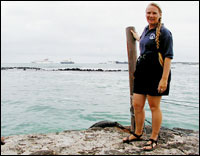
Cruise ships in the bay.
Photo: CDRS.
Around 1 p.m., I finally get some quiet time to catch up on my email. There are lots of special visitors coming in the next weeks so I divvy up the load between the PR team. A familiar face appears at the door. It’s the son of a major donor who has returned to the island twice in as many years. We chat and share memories and plans before he has to dash off to join his group again.
Our onsite “roving reporter” catches me en route to the station general store. We sit in the shade while I update her on training programs the PR staff has done. Training is important to the CDRS, and the staff, which tends to be young and in the formative years of their careers, is encouraged to actively seek courses and participate in seminars.
At least once a week, I visit the science buildings to catch up on the latest news from the field. The ornithologist, Hernan Vargas, has some good news about the progress of the mangrove finch project. Protection of the nests during reproduction seems to be helping to build up the numbers of this very rare bird. The new threats to the birds of Galapagos come in the form of parasites and disease. The results of an international avian-disease workshop arranged by the CDRS and held at Princeton last year established a strategy for dealing with the relatively new presence of avian disease in the islands.
Rosemary and Peter Grant also drop in to visit Hernan. The Grants have spent time on their favorite island, Daphne Major, for over 30 years as participants in our visiting scientists program. Since 1960, the station has assisted, scientifically and logistically, hundreds of researchers from all over the world to conduct short- and long-term studies in Galapagos. Through their extensive studies, Peter and Rosemary have verified that environmental conditions have a real effect on the survival of different life forms — showing that the process of natural selection, proposed by Charles Darwin more than 170 years ago, does indeed function.
Later, I spend time with the United Nations Foundation coordinator discussing a series of publications on invasive species. Funding options sound positive, so it’s back to Sara and Mats to begin work on the new brochures and to arrange for promotional visitors’ packs to be printed in five languages. On reviewing the “to do” list of follow-up for potential donors, I find a couple that need some attention. A few hundred thousand dollars are hanging in the air here, so I dedicate some time to my correspondence.
One of the invitations that the mailman brought earlier in the week requires me to dress up in “Galapagos semiformal” tonight and be at the local main dock by 6 p.m. So it’s computer off and on with the heels and beads for a night of socializing and fun. I have been invited to attend the cocktail gathering for the representative of the British Embassy in Quito. What should have been an hour of civilized company becomes raucous camaraderie till midnight. Galapagos is made for socializing.
Thursday, 3 May 2001
ISLA SANTA CRUZ, Galapagos
A late night and cocktails required a few aspirin and a black coffee before leaving home, but I feel surprisingly good. I went in early today, so I have time to sit and gather my thoughts, eating an assortment of tropical fruit for breakfast. The view has changed again. Two industrial fishing boats positively crowd our little Pelican Bay with their immense size. They are among hundreds of industrial fishing boats illegally plundering the waters of the Galapagos Marine Reserve. The Galapagos National Park is internationally recognized for its extraordinary ecosystem, its remarkable state of conservation, its natural evolutionary processes, its rich biodiversity, and the high number of endemic species. The reserve also has an incredible range of habitats and species.
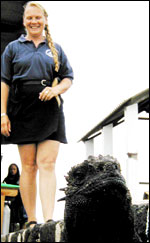
Me with an iguana.
Photo: CDRS.
The fishers of Galapagos practice artisanal fishing (small, locally-based boats using various fishing techniques), and dive for lobster and sea cucumbers. But in recent years, fishing pressure of all kinds has increased rapidly. The lucrative Asiatic markets for sea cucumber and shark fins reached Galapagos in the 1990s, with wide-ranging social and ecological consequences: immigration, widespread illegal fishing, increased numbers of fishers and boats, increased economic expectations of the fishing sector, fishers indebted to unscrupulous traders, and intense conflict between conservationists and fishers.
The Charles Darwin Foundation recommends that fisheries in the marine reserve focus on sustainable management of the resources already being exploited, convert to nonextractive alternatives, and develop selective, low-impact artisanal fisheries in external waters of the reserve in lieu of opening new inshore fisheries. One very important aspect of our work is to strengthen the participatory management system for the reserve, in partnership with other conservationists, scientists, educators, the fishing sector, the tourism sector, naturalist guides, and the responsible government bodies. The CDF believes that this participatory model, established by the Special Law of Galapagos, will be the most effective method of sustainable management for the reserve. Extractive uses (fisheries) have by far the greatest potential to modify the ecosystem and therefore require particularly careful control, although artisanal fishing — properly managed — can be a legitimate and appropriate economic activity in the reserve.
Back in the office, Sara and I review the plans for an upcoming film group’s visit. We have been encouraging film groups to focus part of their programs on the fragility of the ecosystem and how, without the efforts of the CDF and Galapagos National Park, things would be very different. This group is interested in sea lions, so there are some extra logistics in helping them meet with our Ecuadorian marine scientist in charge of the sea lion monitoring and gaining permission to film in the field on a nearby island. The CDF considers film groups as opportunities to reach a sizeable public to increase local and worldwide concern for the conservation of the islands.
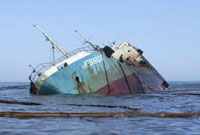
The oil tanker Jessica.
Photo: Todd Lyons, USCG (courtesy CDRS).
The office is pleasantly icy from the obligatory air-conditioning for the computers. Several meetings were rescheduled this morning, so I managed to get completely up to date with the emails by lunchtime without distraction. It’s a nice change from the frenetic pace of the past weeks, which saw us responding to a deluge of inquiries and offers of help during the oil spill crisis. On 16 Jan., the oil tanker Jessica ran aground off the coast of San Cristobal Island. The CDRS and the GNPS coordinated on oil spill monitoring and cleanup activities, involving scientists from South Africa and the U.S. with experience cleaning up after oil spills and treating affected animals and birds.
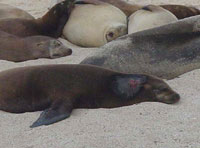
Sea lions injured by the spill.
Photo: CDRS.
Long-term impacts of the spill are now being evaluated. Observations based on the incomplete evidence available so far corroborate initial impressions that impacts of the spill will be widespread, but not severe. The CDRS and the GNPS are undertaking a full evaluation and prolonged monitoring of selected sites and species. The hundreds of emails we received daily inspired us all.
Today is our administrative officer’s last day, so we spend some time with her and reorganize her work into our schedules. More pressing local news is the latest topic of internal email discussion. Do we need to provide nesting sites for the marine iguanas onsite and protect them from the constant traffic? The municipal council recently paved the road to the station and over the last couple years, hundreds of cars have been brought to Isla Santa Cruz. More people, more cars, paved roads — this all means fewer nesting sites for the endemic marine iguana. The dozens of baby iguanas on the station road we dodge on our bicycles become grim street decoration under the wheels of cars.
Picking up lunch, I run into my good friends Priscilla Martinez and her husband, Fernando Rivera. These two marine biologists are fixtures at the CDRS, recently returned from studies in Australia. Until recent years, the islands had few people and few facilities. Friendships forged in those times have an almost historic connotation and remain part of the social fabric of the community.
Mason is at work with me this afternoon, as I am escorting the British Embassy representative and his young daughter on an in-depth tour of our facilities. We take them to visit the newly hatched babies in the captive breeding program for the Galapagos giant tortoises, then to see the real stars of any visit to Galapagos — the adult giant tortoises. All the species are endangered. The captive breeding program is slowly building up the population, while scientists work in coordination with the management programs of the GNPS to restore the entire ecology of islands, not just individual species. Mason loves to visit the tortoises. He knows all the rules — and is not averse to making other visitors aware of them.
On the way home, I visit a writer and her photographer husband to discuss an Australian Geographic article about the group of Australians at the CDRS. Mason and I finish the day by watching the documentary on reptiles that was sent to me by Partridge films.
Friday, 4 May 2001
ISLA SANTA CRUZ, Galapagos
This morning, I review the script for a new promotional video, revise details for the onboard monitoring program, and sketch out ideas for new brochures. With few requests for presentations today, it is time to play catch-up. It is also my day for undisturbed meetings with Robert Bensted Smith, director of the Charles Darwin Research Station and — by default — head of the external relations department. We discuss the department news, and I get updated on the CDRS higher-level decisions of the week.
Today we are joined by the representative of the CDRS on San Cristobal, a populated island where the CDRS presence has historically been minimal. There is a now an emphasis on increasing awareness of our work and expanding the CDRS activities on the island.

A tourist group, with plants.
Photo: CDRS.
San Cristobal is where we carry out some of our most extensive invasive plant programs, studying introduced plant species and their interaction with native and agricultural species. There is an ongoing project investigating the ecology (reproduction, dispersal, seed bank dynamics) and control of Rubus niveus (blackberry), a plant that infests many thousands of acres of national park and agricultural land. Introduced species present the greatest danger for the conservation of the terrestrial ecosystems of Galapagos, and any advance in the control of introduced species is important. The CDRS works directly with local farmers to encourage them to combat introduced species. Training workshops take place on demonstration farms using new methods of horticulture and composting, and credit concessions have been arranged for local farmers to enable them to improve their irrigation systems.
With the planned closing of the main airport on Santa Cruz for a month, there is a need to move some of our PR and outreach activities over to San Cristobal. This situation gives us the opportunity to promote the work of the station to the tourist sector, improve and strengthen our relationship with the San Cristobal community, and promote the Friends of Galapagos campaign. As an international nonprofit, our financing largely depends on Friends of Galapagos. The worldwide network allows us to maintain our conservation activities, assures financial stability of the Charles Darwin Foundation, and promotes our commitment to conservation around the globe.
The new Environmental Education Center and the regular CDRS-produced radio and television programs have made large inroads into the local community. Children are the main beneficiaries of the activities of the EEC, where they have access to learning methods designed to stimulate the capacity for observation and investigation. The EEC supports curriculum reform, which seeks to adapt education in Galapagos to its island environment. A long-term project for training local teachers began in 1998. In coordination with this program, the CDRS produces educational books. Eventually, 10 books, which correspond with the 10 years of Ecuadorian basic education, will be produced. Already, more than 1,200 students have benefited from the three books now in circulation. Mason started school the same year the first book was released, so he will grow up with this new system.
Today Mason goes to the recently formed scout group, so I work through lunch until he arrives. The last couple of hours of my workday get cancelled, and we go to the station beach to relax for the short time we have to spend together.
My work night begins again about 8:30 p.m., when Mason is asleep and I have a couple of undisturbed hours to finish writing a book review. This is also when I write drafts for any leftover email and pending reports, jot down ideas, sort through notes in my agenda, and generally put a close to the workweek. Long gone are the days of rum and dancing salsa and traditional weekend revelry. Every Galapagos day brings new challenges, stimulation, and entertainment. And much of this I owe to my position at the Charles Darwin Research Station and these very special islands that deserve our best efforts to protect them.

